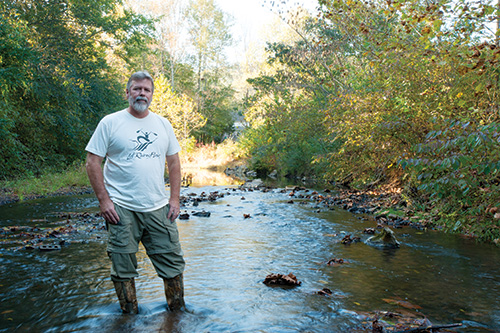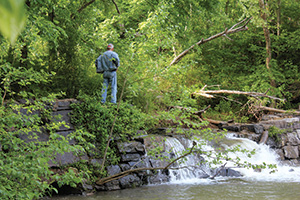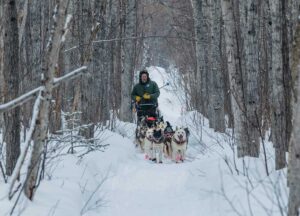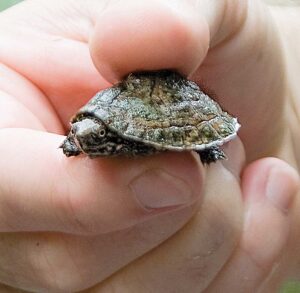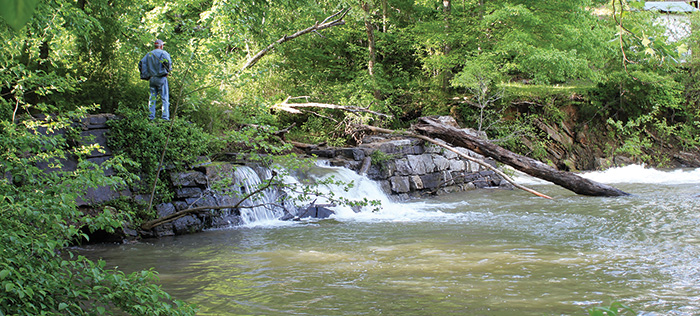
Doug Morrison, a strong voice for conservation
Story by Leigh Pritchett
Photos by Wallace Bromberg Jr.
Doug Morrison does not consider himself to be a hero.
He is just a man who appreciates God’s green earth, blue skies and crystal-clear waters, and he wants to keep them that way.
The Alabama Rivers Alliance sees it a little differently, though. Because Morrison has worked to protect creeks, rivers and their surroundings, the Springville resident was named a “2015 River Hero” by the alliance earlier this year.
“I was just doing my thing and loving doing it,” said Morrison, who picks up litter along St. Clair County Road 9 near the Big Canoe Creek bridge during his lunch hour.
The River Hero Award, according to the non-profit alliance, is “a lifetime achievement award given to passionate individuals who exemplify river stewardship and who have a rich history of advocating for the protection of Alabama’s waterways.”
Morrison, notes the alliance, received the award for helping to revive the Friends of Big Canoe Creek organization, for being president of the Coosa Riverkeeper, for working with Freshwater Land Trust to establish a Forever Wild preserve along a portion of Big Canoe Creek, and for being supportive of Alabama Rivers Alliance and other riverkeeper groups.
Morrison serves as president of the Friends of Big Canoe Creek, which has 50-60 members, and president of the Coosa Riverkeeper until his term expires this December.
“Every conservation project I’ve ever been involved in, there has been a champion,” said Wendy Jackson, executive director of the non-profit Freshwater Land Trust. “For Big Canoe Creek, that champion has been Doug Morrison, who has invested countless hours of his time and all of his heart to this project. Not only is he a river hero, he is my hero.”
Though Morrison is the one who received the award, he said he has not worked alone. He said both groups – the Friends of Big Canoe Creek and the Coosa Riverkeeper — have board members and membership “with the same passion and want to help.”
Morrison’s journey to becoming a waterway champion actually started with a visit to Homestead Hollow in Springville.
During the excursion, Morrison and Joannie, his wife of 30 years, happened to drive along Oak Grove Road and into downtown Springville and decided this was the place for them.
They wanted to escape city life.
At the time, Morrison, an information technology consultant in the 401K record-keeping field, and his wife lived in Center Point.
A few years later, they saw an advertisement about a home for sale in Springville. The description mentioned a creek bordering the land.
When they visited the property, Mrs. Morrison explored the inside of the Victorian-style home, with its side turret and stained-glass transoms. Morrison, on the other hand, checked out Big Canoe Creek that flows about 140 yards from the home’s back deck. The pleasant childhood memories of looking for crawfish in Shades Creek in Jefferson County flooded his mind. Immediately, he was sold on the property.
That was in 1999.
For a while, he was content to sit next to his creek and occasionally be involved in various projects of Friends of Big Canoe Creek.
That changed noticeably after he saw neighbor Philip Dabney kayaking on the creek one day. Morrison decided he would like to do that, too.
As Morrison paddled in a kayak or canoe, he noticed details about the creek, the life in and around it, and the vegetation.
His fascination with the creek increased, and so did his activity on it. He took up wade fishing; he set a goal of paddling the creek all the way to Neely Henry Lake. (He has paddled about half of it to date.)
“As I paddled it and started networking with other river groups, (I discovered) a lot of creatures there, what depends on the clean water and what harms the water,” Morrison said.
More and more, he realized the importance of protecting this pristine creek that flows in the shadow of an Appalachian foothill.
With the help of neighbor Vickey Wheeler, a founding member of the original Friends of Big Canoe Creek, Morrison was able to reactivate the group in 2008.
Now called the Friends of Big Canoe Creek, the group has engaged during the past seven years in cleaning up the creek and its tributaries, monitoring watershed, testing water quality, promoting recreation and fishing, educating the community and planning special events.
When Morrison learned that the group, Coosa Riverkeeper, was forming, he wanted to participate because Big Canoe Creek is in the Coosa River watershed. Morrison was asked to serve on the board of directors and has been president for three years.
Representing the Friends of Big Canoe Creek, Morrison and Board members have worked with Freshwater Land Trust’s Executive Director Wendy Jackson, city and county officials to designate between 300 and 600 acres adjoining the creek as a preserve through the state’s Forever Wild program.
“We are continuing efforts to make Big Canoe Creek Nature Preserve a reality and are still working hard to see this through. Many wonderful folks have been involved, and there seems to be a genuine interest in having green space for folks to recreate in nature, to get their kids outdoors, away from their electronic life and truly experience what nature has to offer.
“In a book by Richard Louv, called Last Child in the Woods, he used the phrase, ‘Nature Deficit Disorder.’ That hit home with me, and I see how important it is to get folks back to nature, to have a place to sit quietly, listen to the forest, observe the creatures in the forest and listen to the simple sounds of a running stream. It is just downright good for your soul. So we are working hard to make this happen for the community, where folks can get away to a place in their neck of the woods and enjoy a natural setting.”
Unique creek
Big Canoe Creek begins at Zamora Lake Park in Clay in Jefferson County and crosses northern St. Clair County. When the creek reaches Gadsden in Etowah County, it becomes part of the Coosa River.
As Big Canoe Creek winds along its 50-mile path, it is fed by Gulf Creek, Muckleroy Creek, a Little Canoe Creek near Springville and another Little Canoe Creek in Etowah County.
One of its unique aspects is that it flows northeasterly, Morrison said.
In the creek is an array of fish, such as redhorse sucker, bass, crappie, bream, rainbow shiner, longear sunfish, alligator gar and southern studfish. Some are so colorful that they look tropical.
“Big and Lit-tle Canoe Creeks are home to 54 known species of fish and 23 rare and imper-iled plants and ani-mals doc-u-mented through-out the water-shed,” reveals Freshwater Land Trust.
According to the U.S. Fish and Wildlife Service, two federally protected mussels — the southern pocketbook and the triangular kidneyshell — can be found in Big Canoe Creek. Federal listing is being sought, as well, for the Canoe Creek clubshell mussel and the trispot darter.
The Canoe Creek clubshell mussel “is entirely new to sci-ence and was recently dis-cov-ered,” reports Freshwater Land Trust. As for the trispot darter, it is “a rare fish once thought to be extinct in Alabama.”
In 2004, 18 miles of the creek were deemed a “critical habitat” under the Endangered Species Act, states the Friends of Big Canoe Creek web site (www.bigcanoecreek.org).
A “critical habitat,” explains the wildlife service, is an area that “contains features essential for the conservation of a threatened or endangered species.”
The fact that mussels live in Big Canoe Creek is indeed positive because they require good water quality to exist.
“Their persistence in the Big Canoe Creek watershed is a testament to its ecological integrity,” states www.bigcanoecreek.org.
Wading in the creek one afternoon with a Discover photographer, Morrison came upon a sizable freshwater crustacean.
“There’s a big ole crawfish back there,” he said, estimating the critter to be possibly 6 inches long.
Studies of crawfish in Big Canoe Creek have found quite a diverse population.
“I didn’t know there were so many varieties of them,” Morrison said.
The creek also attracts blue herons, green herons, box turtles, salamanders, minks, otters, owls, raccoons, turkey, deer and many other creatures. Morrison said he has encountered a black coyote and a bobcat that was “one of the biggest … I’ve ever seen.”
In 2013, the Friends of Big Canoe Creek was involved in a huge undertaking to remove part of a 19th century grist mill dam, the only dam on the creek. A study showed that the dam was keeping fish from migrating up and down stream. Also, the pooling of water behind the dam was promoting a buildup of sediment, which was adversely affecting aquatic life.
Seven national, state and local entities teamed to remove a portion of Goodwin’s Mill Dam to let the creek flow unobstructed.
Morrison said a recent biodiversity survey indicated that the different species living in that part of the creek are flourishing since the dam’s removal.
Life changer
Big Canoe Creek and its interests have become an integral part of Morrison’s everyday life.
He has his coffee at the creek some mornings and relaxes there after work. He likes “just sitting on the bank, listening to the water” as it hits the rocks of the shoal. He goes there at night, builds a fire and enjoys the peacefulness.
Often, he gives presentations about the creek, counsels Boy Scouts working toward their sustainability merit badge, presents rain barrel workshops, and encourages groups to practice the three R’s of reduce, reuse, recycle.
Because it is largely hidden, Big Canoe Creek remains untouched with few threats to its ecology. “We’re blessed not to have industry on it,” Morrison said.
However, he does not want the creek to remain a secret.
“I’d like to continue educating people about it,” he said. Specifically, he envisions more video documentation that would “bring to people’s living rooms” the beauty and life in and around Big Canoe Creek.
“People that paddle it get to experience that beauty,” he said. “And once you experience that beauty, you may become like me and want to protect it.”
Whenever he has the opportunity, he talks about Big Canoe Creek and the Coosa River because of water’s importance to man and creature. “In my opinion, anyone who fishes or swims or drinks water from the Coosa watershed ought to be concerned about it and support the work of the Coosa Riverkeeper,” he said.
He encourages people to support riverkeeper efforts in their area because these groups are the “eyes and ears of the water community.”
Morrison realizes that his transformation from a guy who enjoyed a creek to a guy determined to preserve it has been a significant one.
“(The creek) has changed my life,” said Morrison, the father of two and grandfather of four. “I wasn’t into … conservation … until we moved out here. The creek changed me. It has given me a better appreciation of what we have here in our state. To see what we have in our own back yard is incredible. … This may sound corny, but it’s true: Be a better steward of the earth. Enjoy what God has given us, this common ground for all living beings to thrive.”
Information from Alabama Rivers Alliance, Freshwater Land Trust and The Friends of Big Canoe Creek was used with permission.











